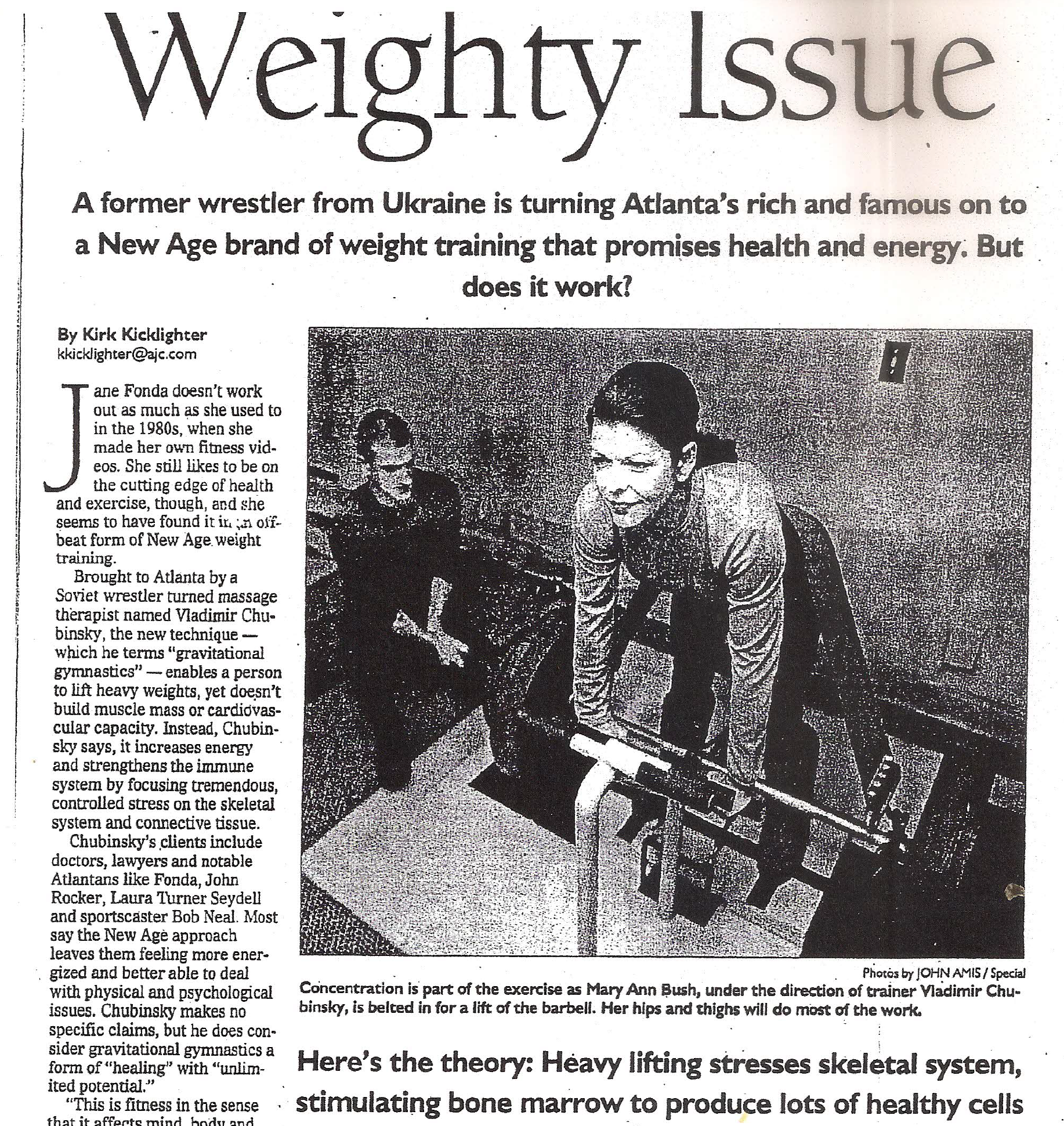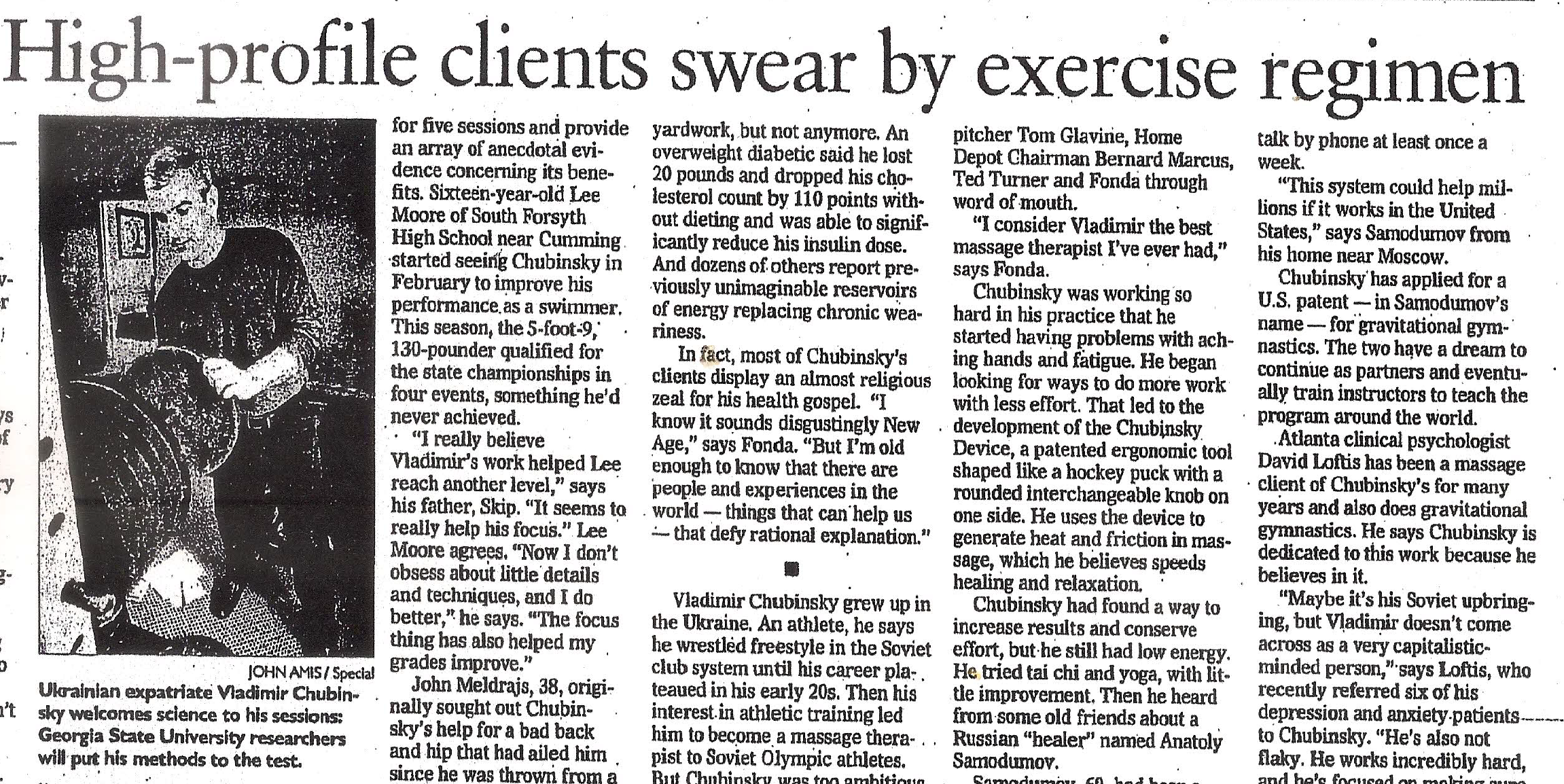A Weighty Issue
A former wrestler from the Ukraine is turning Atlanta’s rich and famous on to a New Age brand of weight training that promises health and energy. But does it work?
BYLINE: Kirk Kicklighter; Staff
DATE: August 30, 2000
PUBLICATION: The Atlanta Journal and The Atlanta Constitution
EDITION: Home; The Atlanta Constitution
SECTION: Features
PAGE: E1
Jane Fonda doesn’t work out as much as she used to in the 1980s, when she made her own fitness videos. She still likes to be on the cutting edge of health and exercise, though, and she seems to have found it in an offbeat form of New Age weight training. Brought to Atlanta by a Soviet wrestler turned massage therapist named Vladimir Chubinsky, the new technique — which he terms “gravitational gymnastics” — enables a person to lift heavy weights, yet doesn’t build muscle mass or cardiovascular capacity. Instead, Chubinsky claims, it increases energy and strengthens the immune system by focusing tremendous, controlled stress on the skeletal system and connective tissue.
Chubinsky’s clients include doctors, lawyers and notable Atlantans like Fonda, John Rocker, Laura Turner Seydell and sportscaster Bob Neal. Most say the New Age approach leaves them feeling more energized and better able to deal with physical and psychological issues. Chubinsky makes no specific claims, but he does consider gravitational gymnastics a form of “healing” with “unlimited potential.” “This is fitness in the sense that it affects mind, body and spirit,” says Fonda. “But it’s not an exercise workout, and we don’t know how it works at the molecular level. For me, there is no question that it would help depression, fibromyalgia or even possibly HIV.”
Conventional scientists and physicians, however, are skeptical. “It’s true that overloading the skeletal system is good for the bones, but no one could say it does all those things without proof,” says physical therapist Saku Sundaram at the Medical College of Georgia.
Dr. Rick Hammersfahr, an orthopedist with the Center for Orthopaedics and Sports Medicine in Marietta, a clinical practice that specializes in sports medicine, says he’s not opposed to alternative methods like Chubinsky’s as long as they are subjected to rigorous scientific inquiry. “We tell patients they need to be careful in this area. Sometimes the placebo effect accounts for improvement,” he says. “Someone may feel better simply because they are finally taking steps in that direction.” Chubinsky has negotiated a proposal with researchers at Georgia State University to compare a group of adults doing gravitational gymnastics with another group doing traditional weight training, as a way of quantifying the benefits of his technique.
“We were intrigued from the first time he approached us,” says Dr. Walter Thompson, director of the GSU project and a professor of kinesiology, a multidisciplinary science encompassing anatomy, biomechanics and physiology. “We’re going to look at a whole battery of things, from psychological health to physiology and immune system function. . . . At least Vladimir seems to be doing this the right way. He’s willing to suffer the consequences if research shows his system doesn’t work.” But scientific studies aside, Chubinsky continues to draw clients, largely by word of mouth. With a new studio opening and scientists interested in testing his claims, Chubinsky is on the cusp of bringing great recognition to his technique, which only he and his mentor in Russia practice. Yet he says he is less interested in success and more eager to help people develop the motivation to change their lives.
“Improvement in any part of life makes people happier,” Chubinsky says, while resting between client sessions at his YWBI (for “You Won’t Believe It” and “You Will Believe It”) Wellness Center in Sandy Springs. With his short gray haircut, black jeans and tight T-shirt, he looks like a hip fashion designer. “People think they can improve if they only change their minds,” he adds. “No. You change your energy, and your mind will follow.”
Chubinsky is not licensed in the United States, and Georgia, unlike some states, doesn’t require massage therapists to be licensed. Like many other massage and fitness trainers, he is not required to have any specialized background — though his center is licensed as a limited liability company. He was trained in the Ukraine at the Kiev Institute of Physical Culture, a major Soviet center for sports medicine. There he earned a specialist diploma, the Soviet equivalent for training in exercise physiology and physical therapy. Sixteen-year-old Lee Moore of South Forsyth High School near Cumming started seeing Chubinsky in February to improve his performance as a swimmer. This season, the 5-foot-9, 130-pounder qualified for the state championships in four events, something he’d never achieved. ”I really believe Vladimir’s work helped Lee reach another level,” says his father, Skip. “It seems to really help his focus.” Lee Moore agrees. “Now I don’t obsess about little details and techniques, and I do better,” he says. “The focus thing has also helped my grades improve.”
John Meldrajs, 38, originally sought out Chubinsky’s help for a bad back and hip that had ailed him since he was thrown from a car in an auto wreck at age 18. “After my fifth visit, I started feeling a peaceful euphoria,” says Meldrajs, a carpenter from Alpharetta. “My back and hip felt better, and I noticed my hot temper and road rage were gone. I had never felt so great in my life.”
The stories go on and on. In interviews conducted for this story, a client with fibromyalgia, a disease syndrome whose primary symptoms are muscle pain and fatigue, says she once needed three days to recover from simple yardwork, but not anymore. An overweight diabetic said he lost 20 pounds and dropped his cholesterol count by 110 points without dieting and was able to significantly reduce his insulin dose. And dozens of others report previously unimaginable reservoirs of energy replacing chronic weariness.
In fact, most of Chubinsky’s clients display an almost religious zeal for his health gospel. “I know it sounds disgustingly New Age,” says Fonda. “But I’m old enough to know that there are people and experiences in the world — things that can help us — that defy rational explanation.”
Vladimir Chubinsky grew up in the Ukraine. An athlete, he says he wrestled freestyle in the Soviet club system until his career plateaued in his early 20s. Then his interest in athletic training led him to become a massage therapist to Soviet Olympic athletes. But Chubinsky was too ambitious and restless to remain in the Ukraine. By the end of the ’80s he was setting his sights on America.
“The United States has many problems,” says Chubinsky, “but it’s a place where a person can grow.” Chubinsky, wife Inga and their 3-month-old baby arrived in Atlanta in May 1990. He wasted no time establishing himself as a massage therapist, opening his own practice in 1994. Soon he was attracting such high-profile clients as Atlanta Braves pitcher Tom Glavine, Home Depot Chairman Bernard Marcus, Ted Turner and Fonda through word of mouth.
“I consider Vladimir the best massage therapist I’ve ever had,” says Fonda. Chubinsky was working so hard in his practice that he started having problems with aching hands and fatigue. He began looking for ways to do more work with less effort. That led to the development of the Chubinsky Device, a patented ergonomic tool shaped like a hockey puck with a rounded interchangeable knob on one side. He uses the device to generate heat and friction in massage, which he believes speeds healing and relaxation.
Chubinsky had found a way to increase results and conserve effort, but he still had low energy. He tried tai chi and yoga, with little improvement. Then he heard from some old friends about a Russian “healer” named Anatoly Samodumov. Samodumov, 60, had been a Soviet powerlifter in his younger days, but also studied science and religion. His studies led him to develop gravitational gymnastics, and he eventually used his system in 12 gyms in the Moscow area, working with nearly 5,000 clients until the failing Russian economy closed all but one in the late 1990s. Chubinsky invited Samodumov to the United States in May 1997. The two became friends and spent weeks building a gravitational gymnastics studio in Vladimir’s basement. They still talk by phone at least once a week.
“This system could help millions if it works in the United States,” says Samodumov from his home near Moscow. Chubinsky has applied for a U.S. patent — in Samodumov’s name — for gravitational gymnastics. The two have a dream to continue as partners and eventually train instructors to teach the program around the world.
Atlanta clinical psychologist David Loftis has been a massage client of Chubinsky’s for many years and also does gravitational gymnastics. He says Chubinsky is dedicated to this work because he believes in it.
“Maybe it’s his Soviet upbringing, but Vladimir doesn’t come across as a very capitalistic-minded person,” says Loftis, who recently referred six of his depression and anxiety patients to Chubinsky. “He’s also not flaky. He works incredibly hard, and he’s focused on making sure it will have a positive impact.” Friends and clients have told Chubinsky he should pull up stakes and head to California, where alternative healing and fitness are more readily embraced than in Georgia. ”People say so many things. They say I need more marketing, or I need to change the name. Maybe I could be really big in Los Angeles, no?” he says. “I don’t want that yet. I want to stay here and prove this works. The rest will come.”


